Albert Ammons was one of the founding fathers, in a sense, of boogie woogie piano, and along with his Chicago compatriots Meade "Lux" Lewis and Jimmy Yancey, briefly rode the wave of national popularity of that genre in the late 1930s. He was born in Chicago, Illinois, to 17-year-olds James Wesley Ammons of Memphis, Tennessee, and Anna Elizabeth Sherman of Owensborough, Kentucky. Some sources show a birth date of September 23, but it is unclear where such a date was derived. Public records from the time of his birth forward clearly indicate a March 1 date. James and Anna were married seven months prior on August 9, 1906. In 1908, James Wesley, Jr., would join the family.
The 1910 enumeration taken in Chicago showed James working as a waiter in a club. It is very probable that he was exposed to evolving piano styles during his nightly work, and the elder Ammons developed an interest in the emerging genre that would become barrelhouse or boogie piano. Both James and Anna were reportedly pianists of some ability, so music came naturally to their oldest son. At some point the Ammons family acquired a player piano for their home, and by age ten Albert was learning to play. He often picked up pieces the way so many young players did at that time, by playing a roll very slowly and watching which keys were depressed so he could emulate it, even though much of the time rolls were a bit over-arranged for two hands, often sounding more like four. Through this process he gained some understanding of chords and harmony.
At some point in his early teens, Albert was befriended by Meade Lewis, who was around 18 months his senior. As Lewis had no piano in his home, he spent hours every week at the Ammons residence using their instrument. No doubt that trading ideas back and forth helped the boys teach each other some facets of playing, and gave them a similar style, albeit Albert was typically a bit more aggressive in his playing than Meade. Albert was also a percussionist for a Chicago drum and bugle corps, which led to trap drum skills. In this capacity, he occasionally worked in Chicago nightclubs, likely lying about his age to get past union rules. Through this he and Meade were exposed to the blues at a level that was currently unavailable via piano rolls, sheet music or recordings. Lewis and Ammons had yet another pianistic friend named Toy, according so some sources, and it was at Toy's piano in 1923 that he worked out his signature piece, the as yet unnamed Honky Tonk Train Blues, although it would not be committed to disc for another four years.
The dynamic changed when on May 21, 1923, Albert was married to Lila Sherrod, one of a set of twin sisters from Russellville, Kentucky. She was barely 15 to his 16, but both claimed to be substantially older nine months later when their daughter Edsel was born on February 17, 1924. On April 14, 1925, Eugene Stanley Ammons would join the growing brood. Throughout this period Albert continued to hone his drumming and piano skills, working in clubs whenever and wherever he could. He hung out quite often with Lewis, both of whom had become taxi drivers by trade for the Silver Taxicab Company. There is an account (hard to confirm) that the owner, who had several musicians in his employ, installed a piano in the lounge at the shop to give the drivers incentive to return back to the shop with regularity. Albert and Meade drove by day, then played for rent parties at night. They soon shared an apartment together, when Lewis moved in with Meade and his young bride Lila. While they were first developing their piano style, it was not yet quite boogie woogie, but more barrelhouse ragtime. However, around 1923 to 1924 they either heard a recording of The Rocks as played by its composer, George Washington Thomas of Alabama, or more likely a performance of The Fives by the same composer, played by somebody in Chicago. Either way, it spurred them on to learn and further develop the rolling boogie woogie left-hand style that would become their individual signatures.
While they continued to ply their passions at night, Ammons managed to find work for Lewis with a band in Chicago, but Albert was unable to hold the job long. Although he was skilled at repeating melodies he heard, he was limited at that time to playing mostly in the keys of C and G, rather than the flatted key signatures largely favored by jazz bands. Meade did manage to get steady work playing for parties in Detroit in 1926, where he and Ammons had moved by that time, given a slightly less ambitious but still well-established black musical community. These gatherings came with a certain risk since alcohol was usually present, despite national prohibition. Whenever a police raid occurred, Meade and Albert learned how to quickly get out on a balcony or ledge, wait for the police to leave with a few suspects, then take some of the brew for themselves.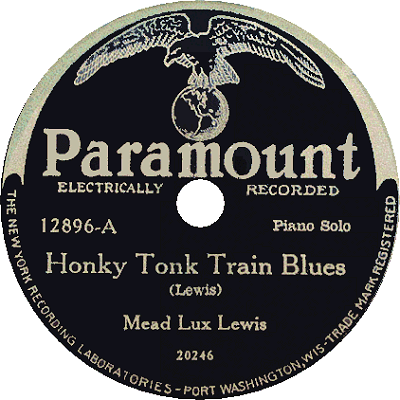 Within a year or so the boys had relocated to South Bend, Indiana, where Ammons was hired by the Paradise Inn. Lewis managed to get a job playing piano in a brothel, and possibly managing it as well. Within a few months, however, they would return home to Chicago. It also appears that his wandering, and potentially some philandering, created a void in his marriage, and by 1927 he was either separated or divorced from Lila. She and her childen moved in with her parents, James and Irene Sherrod, where she would be found into the 1940s.
Within a year or so the boys had relocated to South Bend, Indiana, where Ammons was hired by the Paradise Inn. Lewis managed to get a job playing piano in a brothel, and possibly managing it as well. Within a few months, however, they would return home to Chicago. It also appears that his wandering, and potentially some philandering, created a void in his marriage, and by 1927 he was either separated or divorced from Lila. She and her childen moved in with her parents, James and Irene Sherrod, where she would be found into the 1940s.
 Within a year or so the boys had relocated to South Bend, Indiana, where Ammons was hired by the Paradise Inn. Lewis managed to get a job playing piano in a brothel, and possibly managing it as well. Within a few months, however, they would return home to Chicago. It also appears that his wandering, and potentially some philandering, created a void in his marriage, and by 1927 he was either separated or divorced from Lila. She and her childen moved in with her parents, James and Irene Sherrod, where she would be found into the 1940s.
Within a year or so the boys had relocated to South Bend, Indiana, where Ammons was hired by the Paradise Inn. Lewis managed to get a job playing piano in a brothel, and possibly managing it as well. Within a few months, however, they would return home to Chicago. It also appears that his wandering, and potentially some philandering, created a void in his marriage, and by 1927 he was either separated or divorced from Lila. She and her childen moved in with her parents, James and Irene Sherrod, where she would be found into the 1940s.The building the pair moved into was coincidentally where yet another developing boogie woogie pianist, Clarence "Pine Top" Smith, resided with his wife. By late 1927 (possibly early 1928), Smith had relocated to the Windy City from Pittsburgh by way of the Theatre Owners Booking Association (TOBA), which included extensive tours of the South and Texas. (There are sources claiming they had been together much earlier, but Smith's time line negates that possibility.) The trio became inseparable pianistic sparring partners, sharing ideas and jamming together at parties. It is likely that Pine Top exerted some influence on Ammons and Lewis, showing them some of the Texas style of barrelhouse, and they probably returned the favor showing him their own licks. In fact, Lewis' Honky Tonk Train Blues is close in structure and sound to Smith's Pine Top's Boogie-Woogie, although the nature of the cross-influence is difficult to pinpoint with any certainty. Given that Lewis had recorded his piece around the time or perhaps even before he met Smith, he probably set the template. One more influence was Chicago pianist and eventual mentor Jimmy Yancey, who left an indelible imprint on Albert, Meade, and the ill-fated Smith, as well as a long friendship, perhaps kinship.
In 1927, Meade became acquainted with a girl who worked for a publishing company, and she managed to get him a recording date. His first important recording of Honky Tonk Train Blues was initially cut in December of 1927 in Chicago. Despite, or perhaps because of its revolutionary sound, the company did not release it until 1929. Although Albert and Meade's primary style of the mid-1920's is considered boogie, which is the boogie rhythm with a non-moving bass line, Albert and his companions soon developed their own individual styles of boogie-woogie, the hard-driving "eight to the bar" blues that had originated in the deep South, particularly New Orleans, and concurrently in Texas and Alabama. The players had added a moving bass line to the boogie pattern, often with blue notes in the left hand. The early recordings of Lewis and his peers, including Yancey and Charles "Cow Cow" Davenport, helped to establish boogie-woogie as a major blues piano style in the late l920's and into 1930.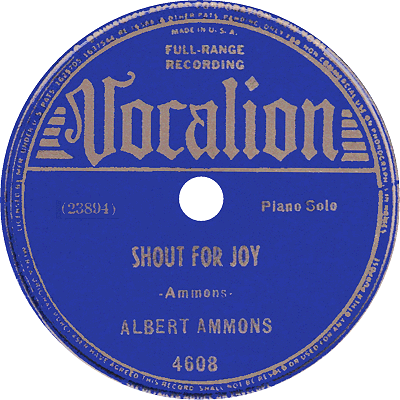 But it was still considered to be black music, and was therefore relegated to "race" labels like Paramount, Vocalion, Gennett and OKeh. In December of 1928, a year after Meade's recording, and then in January of 1929, Pine Top would record eight sides for the Vocalion label, a recently acquired subsidiary of Columbia Records, which released them even before Meade's initial effort. However, Smith was accidently killed at the age of 25 that March, creating a void in the Chicago blues piano community. With Smith's demise and the onset of the world-wide Great Depression in 1930, interest in boogie woogie music started to fade as people turned to swing music and movie musicals for entertainment.
But it was still considered to be black music, and was therefore relegated to "race" labels like Paramount, Vocalion, Gennett and OKeh. In December of 1928, a year after Meade's recording, and then in January of 1929, Pine Top would record eight sides for the Vocalion label, a recently acquired subsidiary of Columbia Records, which released them even before Meade's initial effort. However, Smith was accidently killed at the age of 25 that March, creating a void in the Chicago blues piano community. With Smith's demise and the onset of the world-wide Great Depression in 1930, interest in boogie woogie music started to fade as people turned to swing music and movie musicals for entertainment.
 But it was still considered to be black music, and was therefore relegated to "race" labels like Paramount, Vocalion, Gennett and OKeh. In December of 1928, a year after Meade's recording, and then in January of 1929, Pine Top would record eight sides for the Vocalion label, a recently acquired subsidiary of Columbia Records, which released them even before Meade's initial effort. However, Smith was accidently killed at the age of 25 that March, creating a void in the Chicago blues piano community. With Smith's demise and the onset of the world-wide Great Depression in 1930, interest in boogie woogie music started to fade as people turned to swing music and movie musicals for entertainment.
But it was still considered to be black music, and was therefore relegated to "race" labels like Paramount, Vocalion, Gennett and OKeh. In December of 1928, a year after Meade's recording, and then in January of 1929, Pine Top would record eight sides for the Vocalion label, a recently acquired subsidiary of Columbia Records, which released them even before Meade's initial effort. However, Smith was accidently killed at the age of 25 that March, creating a void in the Chicago blues piano community. With Smith's demise and the onset of the world-wide Great Depression in 1930, interest in boogie woogie music started to fade as people turned to swing music and movie musicals for entertainment.On July 8, 1929 Albert was married once again, this time to Hattie M. Young in Chicago. The 1930 census taken in Chicago showed him working as a musician in a theater, possibly one of the few that had not yet converted to sound films, or more likely one that featured stage shows, and Hattie as a laundress. The Great Depression was in its earliest throes, and Albert, who had not yet recorded, suffered the plight of many of his fellow black musicians; a lack of opportunities for recording, or even radio appearances. Meade, who had cut that one legendary side that opened a door just a crack, would lay down a few tracks for Paramount as an accompanist in late 1930, but then he would also be shut out until 1936. The boogie woogie style was kept more or less localized to the locations where Ammons, Lewis, Yancey and George Thomas played, so was rarely heard in much of the country. Ammons played for the occasional rent party, and found sporadic piano work at Chicago clubs. However, these were all short term gigs which mostly dried up as the Depression deepened. In 1934 he formed a band to play at the Club DeLisa, and managed to keep that steady gig alive for two years. At the same time, he managed to get Meade a job as a private driver. On the last day of the year Albert finally got into a studio to cut a single track, Shout for Joy, for Vocalion.
Thanks to the interest of jazz promoter John Hammond of Columbia Records, who had been listening to the scant roster of recordings made by Meade and his compatriots, Ammons and Lewis were given a new chance to shine. John had been intrigued by Honky Tonk Train, and reportedly spent some two years trying to find the artist, which was most likely how he met up with Ammons in Chicago and got him the recording date with Vocalion. Lewis was located after his concerted search, thanks to Albert's unexpected help.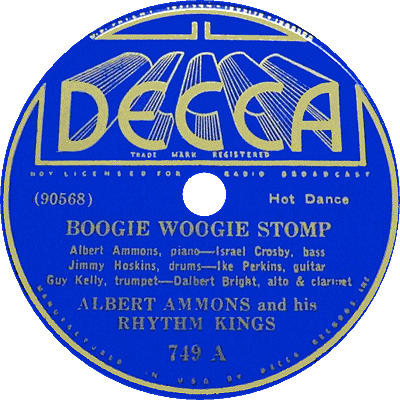 It was partially coincidental, according to a 1939 syndicated article by George Ross. As Hammond, visiting Chicago in late 1935, was talking with Ammons and another musician, one of them remarked, "Too bad about Meade Lux, ain't it?", to which the promoter jumped up and asked, "Do you mean Meade Lux Lewis, the pianist?" "Sure, that's him. Too bad, ain't it? He's washin' cars in one of them South Side garages." Ammons immediately took John to the location where they found him "drearily at work" at the car wash.
It was partially coincidental, according to a 1939 syndicated article by George Ross. As Hammond, visiting Chicago in late 1935, was talking with Ammons and another musician, one of them remarked, "Too bad about Meade Lux, ain't it?", to which the promoter jumped up and asked, "Do you mean Meade Lux Lewis, the pianist?" "Sure, that's him. Too bad, ain't it? He's washin' cars in one of them South Side garages." Ammons immediately took John to the location where they found him "drearily at work" at the car wash.
 It was partially coincidental, according to a 1939 syndicated article by George Ross. As Hammond, visiting Chicago in late 1935, was talking with Ammons and another musician, one of them remarked, "Too bad about Meade Lux, ain't it?", to which the promoter jumped up and asked, "Do you mean Meade Lux Lewis, the pianist?" "Sure, that's him. Too bad, ain't it? He's washin' cars in one of them South Side garages." Ammons immediately took John to the location where they found him "drearily at work" at the car wash.
It was partially coincidental, according to a 1939 syndicated article by George Ross. As Hammond, visiting Chicago in late 1935, was talking with Ammons and another musician, one of them remarked, "Too bad about Meade Lux, ain't it?", to which the promoter jumped up and asked, "Do you mean Meade Lux Lewis, the pianist?" "Sure, that's him. Too bad, ain't it? He's washin' cars in one of them South Side garages." Ammons immediately took John to the location where they found him "drearily at work" at the car wash.With Hammond's help, both Ammons and Lewis were back in front of the public as performers within weeks. He managed to get them both sessions at Decca Records in early 1936, with Meade cutting newer and better-recorded renditions of Honky Tonk Train Blues, Yancey Special, and a few others. Albert finally laid down a series of representative tracks in early 1936. Now equipped with recordings from a major company in his portfolio, he leveraged this and his energetic music into more work, and started to consider a move to the shifting center of jazz and popular music, New York City. And then, Bob Crosby, younger brother of singer Bing Crosby, was making waves with his own swing orchestra, with its dynamic but self-destructive pianist Bob Zurke. Possibly through Zurke, Bob started to incorporate boogie woogie tunes into his orchestra's lineup, eventually recording both Yancey Special, then Honky Tonk Train Blues, with Zurke at the piano. This seemed to ignite a new interest in boogie woogie among a wider listening audience. Throughout 1938, more articles were appearing in music periodicals and other media concerning boogie woogie. The timing was suddenly right to unleash this music to the world.
So it was that Ammons and Lewis and another Hammond find, Kansas City, Missouri, pianist Pete Johnson followed Benny Goodman's historic 1938 swing concert at Carnegie Hall with an appearance of their own arranged by Hammond on December 23, 1938, From Spirituals to Swing. Almost immediately after their historic appearance in the storied venue, playing six-handed boogie woogie on two pianos to vocals by Joe Turner, a whole new fascination with the genre exploded into the world and cultivated the boogie woogie craze of the early 1940s.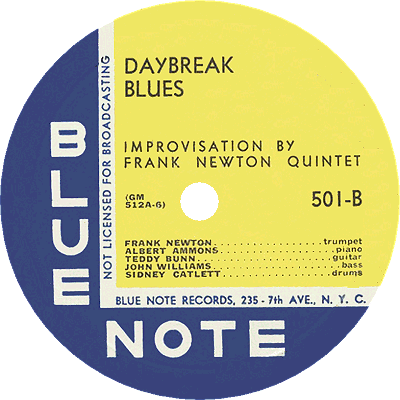 Shortly after the concert, Alan Lomax, who had recently completed the now-famous cycle of recordings by Ferdinand "Jelly Roll" Morton on his life and music, interviewed the trio of Ammons, Lewis and Johnson for the Library of Congress, along with some recordings of their playing. All three of them were further tapped for new records, including the double-sided Boogie Woogie Prayer released on the OKeh and Vocalion labels (and later on Columbia). Separately, Ammons, Johnson and Lewis were also the first artists to record tracks for the newly minted Solo Art label. For Blue Note, a label formed by European player and enthusiast Alfred Lion on the heels of the first Carnegie Hall appearance, Ammons set down several tracks in 1939 that became templates for later players to follow. He also played for sessions in April 1939, with other seasoned musicians from Harlem and beyond, recordings that are still revered by some in the 21st century. Albert would also appear in a second From Spirituals to Swing concert at Carnegie Hall on December 24, 1939, and even that also featured Goodman's sextet and stride pianist James P. Johnson.
Shortly after the concert, Alan Lomax, who had recently completed the now-famous cycle of recordings by Ferdinand "Jelly Roll" Morton on his life and music, interviewed the trio of Ammons, Lewis and Johnson for the Library of Congress, along with some recordings of their playing. All three of them were further tapped for new records, including the double-sided Boogie Woogie Prayer released on the OKeh and Vocalion labels (and later on Columbia). Separately, Ammons, Johnson and Lewis were also the first artists to record tracks for the newly minted Solo Art label. For Blue Note, a label formed by European player and enthusiast Alfred Lion on the heels of the first Carnegie Hall appearance, Ammons set down several tracks in 1939 that became templates for later players to follow. He also played for sessions in April 1939, with other seasoned musicians from Harlem and beyond, recordings that are still revered by some in the 21st century. Albert would also appear in a second From Spirituals to Swing concert at Carnegie Hall on December 24, 1939, and even that also featured Goodman's sextet and stride pianist James P. Johnson.
 Shortly after the concert, Alan Lomax, who had recently completed the now-famous cycle of recordings by Ferdinand "Jelly Roll" Morton on his life and music, interviewed the trio of Ammons, Lewis and Johnson for the Library of Congress, along with some recordings of their playing. All three of them were further tapped for new records, including the double-sided Boogie Woogie Prayer released on the OKeh and Vocalion labels (and later on Columbia). Separately, Ammons, Johnson and Lewis were also the first artists to record tracks for the newly minted Solo Art label. For Blue Note, a label formed by European player and enthusiast Alfred Lion on the heels of the first Carnegie Hall appearance, Ammons set down several tracks in 1939 that became templates for later players to follow. He also played for sessions in April 1939, with other seasoned musicians from Harlem and beyond, recordings that are still revered by some in the 21st century. Albert would also appear in a second From Spirituals to Swing concert at Carnegie Hall on December 24, 1939, and even that also featured Goodman's sextet and stride pianist James P. Johnson.
Shortly after the concert, Alan Lomax, who had recently completed the now-famous cycle of recordings by Ferdinand "Jelly Roll" Morton on his life and music, interviewed the trio of Ammons, Lewis and Johnson for the Library of Congress, along with some recordings of their playing. All three of them were further tapped for new records, including the double-sided Boogie Woogie Prayer released on the OKeh and Vocalion labels (and later on Columbia). Separately, Ammons, Johnson and Lewis were also the first artists to record tracks for the newly minted Solo Art label. For Blue Note, a label formed by European player and enthusiast Alfred Lion on the heels of the first Carnegie Hall appearance, Ammons set down several tracks in 1939 that became templates for later players to follow. He also played for sessions in April 1939, with other seasoned musicians from Harlem and beyond, recordings that are still revered by some in the 21st century. Albert would also appear in a second From Spirituals to Swing concert at Carnegie Hall on December 24, 1939, and even that also featured Goodman's sextet and stride pianist James P. Johnson.The three boogie woogie pianists soon found themselves featured at the Café Society, a Greenwich Village nightclub in lower Manhattan, working as the Boogie Woogie Trio, sometimes billed as the Boogie Woogie Boys when Turner was singing. They collectively ended up playing there regularly for at least two years, and their playing was occasionally broadcast on the air from the club. They would occasionally take time off from New York to play at the Sherman Hotel in Chicago. In both cities they were joined by prominent jazz musicians of the day, both black and white.
He and his cohorts were also featured on a number of radio broadcasts from Chicago, including shortwave shows on CBS intended for the United Kingdom. The 1940 enumeration showed Albert living in Manhattan, possibly divorced from Hattie as the indicator for married was crossed out, and working as a musician in a night club. The playing of Ammons was also used in an abstract animated three-minute short titled Boogie Doodle, which was drawn directly on film by Canadian artist Norman McLaren to Albert's Boogie Woogie Stomp, and released in 1940. Finally tiring of the relentless sharing of the spotlight with the trio, and possibly recognizing that boogie woogie was once again on the wane, Meade left the group in 1941, and Johnson and Ammons decided to also pursue their own direction in music.
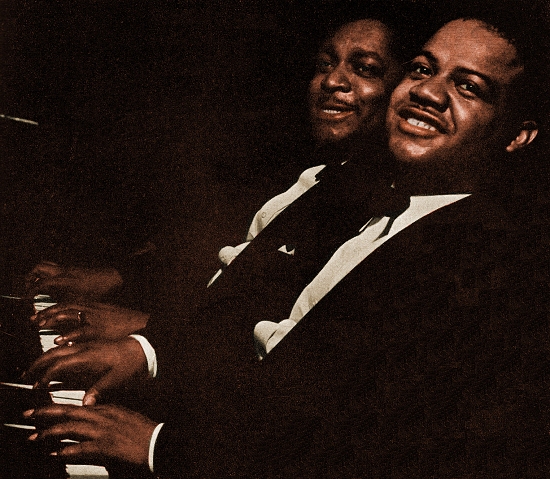 |
The timing is not clear, but there may have been another reason for the breakup of the trio. It has been reported that while making a sandwich in mid-to-late 1941, Albert accidently sliced off part of a fingertip with a kitchen knife. This injury became compounded, perhaps from a form of what is now known as complex regional pain syndrome (CRPS) or a similar ailment, when he temporarily lost the use of both hands from pain and paralysis. Some have speculated that he may have also suffered a stroke or series of micro-strokes which would result in this effect. It was close to two years before he got back to playing strength, a time he most likely spent back in Chicago, but existing documents are vague on this period. By early 1944 Albert was playing and touring again, cutting eight sides for Milt Gabler's Commodore label on February 11. By this time, the craze for boogie woogie, and even swing music, was dying down for a public that was already looking forward to a life beyond the war which would soon come to an end. Fortunately some of his performance style along with Johnson's was captured by the camera in the short film Boogie Woogie Dream, which featured singer Lena Horne and the orchestra of pianist Teddy Wilson. This was followed by a string of successful recordings on the Mercury label from 1945 into 1949.
While it is not clear what type of relationship Albert had with his first wife or son Eugene after his divorce from Lila, the lad took an interest in music at an early age, and in the late 1930s would take up the saxophone. He would also continue a family tradition of getting married at a young age, on his 16th birthday in fact (although claiming to be 21), when he was wed to 17-year-old Laura Shelton in the spring of 1941. After the war, as Gene Ammons, he would join his father in the studio to record a few jazz tracks with singer Sippie Wallace, sister of boogie woogie pioneers George and Hersal Thomas. Gene would go on to enjoy a career of his own on the tenor sax, performing with many iconic figures of bebop and jazz.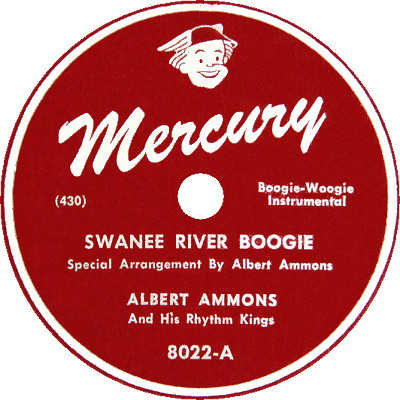 Known as "The Boss", he would ply his trade in soul and rhythm and blues. However, also like his dad, Gene would die before he reached fifty.
Known as "The Boss", he would ply his trade in soul and rhythm and blues. However, also like his dad, Gene would die before he reached fifty.
 Known as "The Boss", he would ply his trade in soul and rhythm and blues. However, also like his dad, Gene would die before he reached fifty.
Known as "The Boss", he would ply his trade in soul and rhythm and blues. However, also like his dad, Gene would die before he reached fifty.Albert would spend his last years playing boogie woogie, blues, and even contemporary tunes of the time, both in Chicago at the Beehive Club and the Tailspin Club, and on the road throughout much of the United States. However, it is difficult to ascertain if he was able to find much success in the Deep South, due to ongoing racial prejudices that most black musicians faced in that part of the country. Just the same, he was able to secure a prestigious gig, hired by another amateur pianist who admired his skill and musicality, Harry S. Truman. Albert played at one of the inaugural gala events in Washington, DC, on January 20, 1949. He was joined by other African American musicians, including jazz singer Lena Horne, classical soprano Dorothy Maynor, and popular vibraphonist Lionel Hampton, who had been employing Ammons as his orchestra pianist for some time.
However, the old injury was a continuing issue, and from time to time the paralysis would temporarily return, depending on the state of Ammons' health. In late November of 1949, Albert visited his old friend Jimmy Yancey, who was also hosting up and coming boogie pianist Don Ewell. He reportedly only had the energy to play one piece (accounts vary) as he was coming out of another bout with the paralysis. This is counter to the stories that he was playing in a club during that same last week of November, so these incidents may have been separated by weeks or months. Either way, he would die on December 2 of allegedly natural causes (again, hard to determine officially) at the age of 42. Ammons, deeply mourned by his colleagues and friends, was buried at Lincoln Cemetery in Worth Township just outside of Chicago. The Cook County death record showed that he may have still been married to Hattie, but that is again a vague reference. He is still remembered today for his aggressive performance style and deep bass lines, and virtually all of his recordings are available in digital formats, and his highly collectible 78-rpm records.
This biography was pieced together from many disparate sources, including several newspaper articles during and after Ammons' lifetime, public records, recording logs and lists, and some additional information from the informative The Story of Boogie Woogie by Peter J. Silvester.
 Selected Discography/Compositions
Selected Discography/Compositions